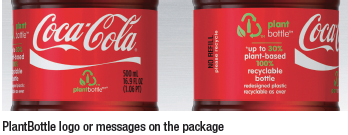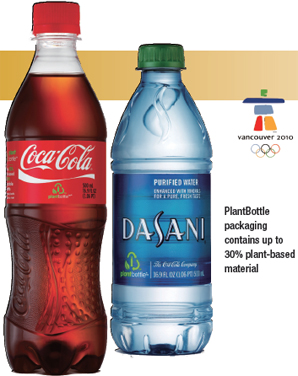
A number of companies worked to impart a message during the 2010 Vancouver Winter Olympic Games that there is an urgent need to save the environment. Such theme was apparent in the decision of the Olympic Committee to use environment-friendly products in all sports events. The Coca-Cola launched its newly designed PlantBottle for its products -- Coca-Cola®, Sprite®, Fresca® and DASANI® at the Winter Olympic Games. The company has been working with its partners to develop a process for making PET plastic bottles that contain a blend of traditional material combined with plant-based material. Its goal is to produce up to 2 billion of these innovative PET plastic bottles by the end of 2010. A PlantBottle PET bottle feels like traditional PET plastic, it has the same weight as traditional PET plastic, it works just like traditional PET plastic, and it is recyclable just like traditional PET plastic -- because it is PET plastic. It also has the PlantBottle logo or messages on the package. PlantBottle packaging contains up to 30% plant-based material. The ultimate goal is to market plastic bottles that are made with 100% renewable raw materials and that are fully recyclable.
Bottle-to-bottle recycling In 2007, The Coca-Cola Company invested over $60 million to build the world's largest bottle-to-bottle recycling plant in Spartanburg, S.C., and to support recycling in the United States. Rather than having to purchase recycled PET plastic to make new bottles, this plant enables the recovery of the company's own PET plastic bottles, process these bottles into resin and create new bottles from that resin. Aside from helping the company achieve its goal of recycling or reusing 100% of its PET plastic bottles in the United States, the bottle-to-bottle recycling plant is expected to eliminate the production of 1 million metric tonnes of carbon dioxide emissions over the next 10 years. Similar investments for bottle-to-bottle recycling facilities are made in Australia, Mexico, Austria and the Philippines.

The Coca-Cola Company has been conducting life cycle assessments on its packaging for more than four decades, giving it data to analyse the environmental impact of its packaging and helping it to identify opportunities for improving its footprint. Preliminary research has indicated that from the growing of the plant materials through to the production of the resin, the carbon footprint of the PlantBottle is less than the carbon footprint of traditional PET plastic bottles made exclusively from non-renewable, petroleumbased material.
Material sources The PlantBottle packaging consists of PET plastic that is made with up to 30% material derived from sugar cane juice or molasses, which is a by-product of sugar cane processing. The sugar cane and molasses comes from Brazil, where it is primarily rain-fed and grown on abundant arable land. Most growers in Brazil recycle process water and increasingly use organic fertilisers. Today, about 50% of the sugar cane in the Sao Paulo area, the main sugar cane region, is harvested mechanically, which eliminates the need to burn fields. Growers in the region have agreed to stop all burning of fields by 2017. In addition, 99.7% of the sugar cane fields are at least 2,000 km from Amazonia. The company has been working with a number of organisations to stress the importance of sustainable agriculture and implement sustainable farming practices in various parts of the world. (the finished)
Nike Air Max 95 A number of companies worked to impart a message during the 2010 Vancouver Winter Olympic Games that there is an urgent need to save the environment. Such theme was apparent in the decision of the Olympic Committee to use environment-friendly products in all sports events. The Coca-Cola launched its newly designed PlantBottle for its products -- Coca-Cola®, Sprite®, Fresca® and DASANI® at the Winter Olympic Games. The company has been working with its partners to develop a process for making PET plastic bottles that contain a blend of traditional material combined with plant-based material. Its goal is to produce up to 2 billion of these innovative PET plastic bottles by the end of 2010. A PlantBottle PET bottle feels like traditional PET plastic, it has the same weight as traditional PET plastic, it works just like traditional PET plastic, and it is recyclable just like traditional PET plastic -- because it is PET plastic. It also has the PlantBottle logo or messages on the package. PlantBottle packaging contains up to 30% plant-based material. The ultimate goal is to market plastic bottles that are made with 100% renewable raw materials and that are fully recyclable. Bottle-to-bottle recycling In 2007, The Coca-Cola Company invested over $60 million to build the world's largest bottle-to-bottle recycling plant in Spartanburg, S.C., and to support recycling in the United States. Rather than having to purchase recycled PET plastic to make new bottles, this plant enables the recovery of the company's own PET plastic bottles, process these bottles into resin and create new bottles from that resin. Aside from helping the company achieve its goal of recycling or reusing 100% of its PET plastic bottles in the United States, the bottle-to-bottle recycling plant is expected to eliminate the production of 1 million metric tonnes of carbon dioxide emissions over the next 10 years. Similar investments for bottle-to-bottle recycling facilities are made in Australia, Mexico, Austria and the Philippines.
A number of companies worked to impart a message during the 2010 Vancouver Winter Olympic Games that there is an urgent need to save the environment. Such theme was apparent in the decision of the Olympic Committee to use environment-friendly products in all sports events. The Coca-Cola launched its newly designed PlantBottle for its products -- Coca-Cola®, Sprite®, Fresca® and DASANI® at the Winter Olympic Games. The company has been working with its partners to develop a process for making PET plastic bottles that contain a blend of traditional material combined with plant-based material. Its goal is to produce up to 2 billion of these innovative PET plastic bottles by the end of 2010. A PlantBottle PET bottle feels like traditional PET plastic, it has the same weight as traditional PET plastic, it works just like traditional PET plastic, and it is recyclable just like traditional PET plastic -- because it is PET plastic. It also has the PlantBottle logo or messages on the package. PlantBottle packaging contains up to 30% plant-based material. The ultimate goal is to market plastic bottles that are made with 100% renewable raw materials and that are fully recyclable. Bottle-to-bottle recycling In 2007, The Coca-Cola Company invested over $60 million to build the world's largest bottle-to-bottle recycling plant in Spartanburg, S.C., and to support recycling in the United States. Rather than having to purchase recycled PET plastic to make new bottles, this plant enables the recovery of the company's own PET plastic bottles, process these bottles into resin and create new bottles from that resin. Aside from helping the company achieve its goal of recycling or reusing 100% of its PET plastic bottles in the United States, the bottle-to-bottle recycling plant is expected to eliminate the production of 1 million metric tonnes of carbon dioxide emissions over the next 10 years. Similar investments for bottle-to-bottle recycling facilities are made in Australia, Mexico, Austria and the Philippines.  The Coca-Cola Company has been conducting life cycle assessments on its packaging for more than four decades, giving it data to analyse the environmental impact of its packaging and helping it to identify opportunities for improving its footprint. Preliminary research has indicated that from the growing of the plant materials through to the production of the resin, the carbon footprint of the PlantBottle is less than the carbon footprint of traditional PET plastic bottles made exclusively from non-renewable, petroleumbased material. Material sources The PlantBottle packaging consists of PET plastic that is made with up to 30% material derived from sugar cane juice or molasses, which is a by-product of sugar cane processing. The sugar cane and molasses comes from Brazil, where it is primarily rain-fed and grown on abundant arable land. Most growers in Brazil recycle process water and increasingly use organic fertilisers. Today, about 50% of the sugar cane in the Sao Paulo area, the main sugar cane region, is harvested mechanically, which eliminates the need to burn fields. Growers in the region have agreed to stop all burning of fields by 2017. In addition, 99.7% of the sugar cane fields are at least 2,000 km from Amazonia. The company has been working with a number of organisations to stress the importance of sustainable agriculture and implement sustainable farming practices in various parts of the world. (the finished)Nike Air Max 95
The Coca-Cola Company has been conducting life cycle assessments on its packaging for more than four decades, giving it data to analyse the environmental impact of its packaging and helping it to identify opportunities for improving its footprint. Preliminary research has indicated that from the growing of the plant materials through to the production of the resin, the carbon footprint of the PlantBottle is less than the carbon footprint of traditional PET plastic bottles made exclusively from non-renewable, petroleumbased material. Material sources The PlantBottle packaging consists of PET plastic that is made with up to 30% material derived from sugar cane juice or molasses, which is a by-product of sugar cane processing. The sugar cane and molasses comes from Brazil, where it is primarily rain-fed and grown on abundant arable land. Most growers in Brazil recycle process water and increasingly use organic fertilisers. Today, about 50% of the sugar cane in the Sao Paulo area, the main sugar cane region, is harvested mechanically, which eliminates the need to burn fields. Growers in the region have agreed to stop all burning of fields by 2017. In addition, 99.7% of the sugar cane fields are at least 2,000 km from Amazonia. The company has been working with a number of organisations to stress the importance of sustainable agriculture and implement sustainable farming practices in various parts of the world. (the finished)Nike Air Max 95
 iConnectHub
iConnectHub
 Login/Register
Login/Register Supplier Login
Supplier Login


























